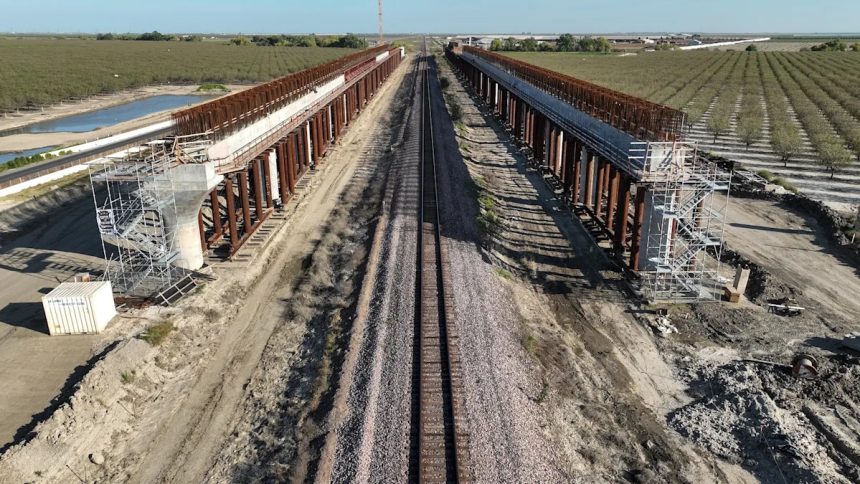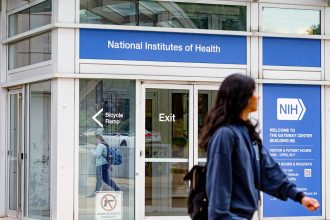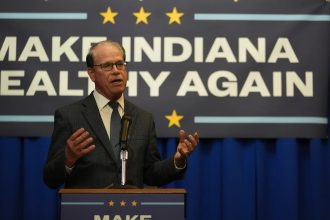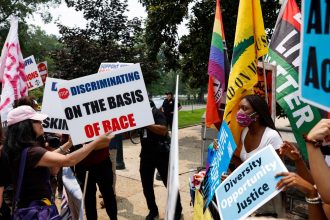Seventeen years ago, Californians bet on a grand vision of the future. They narrowly approved a $10 billion bond issue to build a high-speed rail line that would zip between San Francisco and Los Angeles in under three hours. This technological marvel would slash emissions, revitalize the state’s Central Valley, and, with some financial help from the feds and private sector, provide the fast, efficient, and convenient travel Asia and Europe have long enjoyed.
State officials promised to deliver this transit utopia by 2020. Instead, costs have more than doubled, little track has been laid, and service isn’t expected to begin before 2030 — and only between Bakersfield and Merced, two cities far from the line’s ultimate destinations.
It’s little wonder the project finds itself in a precarious financial position, fighting political headwinds, and deemed a boondoggle by everyone from federal Transportation Secretary Sean Duffy to Abundance authors Ezra Klein and Derek Thompson. “In the time California has spent failing to complete its 500-mile high-speed rail system,” they wrote, “China has built more than 23,000 miles of high speed rail.”
The reasons for this vary with who’s being asked, but people with expertise often cite three fundamental missteps: Creating a new agency to lead the effort, failing to secure adequate funding from the start, and choosing a route through California’s agricultural heartland. The state’s strict environmental review process hasn’t helped, either.
Such struggles are not unique to the Golden State, where support for the project remains strong. Although the private-sector venture Brightline has seen some success, publicly funded high-speed rail efforts in Texas, Ohio, Washington DC, and beyond have stalled. Regulatory complexity, a political environment that favors cars and highways, and constant funding challenges stymie America’s aspirations even as other countries have spent big on tens of thousands of miles of track. Governor Gavin Newsom promises to see the nation’s most ambitious rail project through despite recently losing all federal support, but its troubled path underscores the systemic challenges of building big in America.
California has always been a car-crazy place, and by the early 1990s, transportation studies made clear that its highways would not keep pace with the growth to come. Policymakers saw an answer in bullet trains. The Legislature established the California High-Speed Rail Authority in 1996 and gave it the tough job of planning, designing, building, and running the system.
Some consider that a mistake because the agency lacked experience managing so big a project and navigating complex bureaucracy. Even some rail supporters concede it would have been better to let the authority provide oversight and leave the heavy lifting to the state Department of Transportation, or CalTrans. “It’s building a lot of overpasses and right-of-way, which Caltrans does all the time,” said Ethan Elkind, director of the University of California, Berkeley Climate Program in its Center for Law, Energy and the Environment.
Without that experience, the authority’s 10 employees relied heavily on consultants like engineering firm WSP, running up expenses. “We paid WSP and their predecessor more than $800 million in consulting fees,” said Lou Thompson. He chaired the High Speed Rail Peer Review Group, established in 2008 to provide project oversight, from 2012 until 2024. The authority has in recent years eased its reliance on consultants, who reportedly have gone from 70 percent of its workforce to 45 over the past seven years.
Once the High-Speed Rail Authority set up shop, work proceeded in fits and starts. Even as it considered routes and started the myriad bureaucratic tasks the project required, political interest waxed and waned with the state’s fiscal health. Skeptics lamented the cost and questioned whether bullet trains would attract enough riders to be worthwhile. But rail advocates, environmentalists, unions, and others kept pushing forward and in 2008 convinced voters to approve Proposition 1A, securing $10 billion to finance construction.
It was never going to be enough — at the time, the cost was pegged at $45 billion, a figure that did not account for inflation — and funding has been a challenge from the start.
Cement is laid on the San Joaquin River viaduct portion of the high-speed rail line being built in Fresno, California, on May 8, 2019.
Still, the Obama administration saw an opportunity to show that the economy was bouncing back from the Great Recession. The federal American Reinvestment Recovery Act provided $3.5 billion to help get things started. The authority, which had already mapped a route through the Central Valley, soon began grading land, moving utilities, and taking other steps toward construction of the first leg, a 119-mile stretch from Bakersfield to Madera.
Things chugged along until 2013, when a state judge blocked the use of Prop 1A funds, ruling that some of the work did not meet the rules for bond expenditures. With federal support contingent upon the state’s cash, the federal grants had to be renegotiated — before they expired in 2017. “We were literally sitting there saying, ‘Well, if we don’t start going, we could lose $700 or $800 million of the federal money,” said Dan Richard, who was the High-Speed Rail Authority’s board chair from 2011 until 2019. That prompted the agency to do something no one wanted to do: Move forward without having acquired all of the necessary land. So it did.
Then President Donald Trump took office. He seemed interested in what California was attempting to build, having lamented that China and Japan “have fast trains all over the place” while the U.S. relies upon “obsolete technology.” His opinion soured when Gavin Newsom became governor in 2019 and the two sparred over the president’s policies. Trump later canceled nearly $1 billion in federal funds for the rail project.
The Biden administration restored it and provided another $3.1 billion from the Infrastructure Investment and Jobs Act. The infusion was to help build a station in Fresno and acquire trains for testing. Even with the windfall California remained at least $7 billion short of what it needed for the first short run through the Valley. The situation grew worse in July when Trump rescinded the entire amount after the Federal Railroad Administration said it saw no way of covering that shortfall and no path to completion by 2033.
Newsom said the move “reeks of politics” and the state is suing. But the impact goes beyond California by establishing a precedent to cancel projects at will. “How do you go to your voters and say, ‘Put up the money. We expect 50% federal share,’ without knowing that the next administration could turn around and say, ‘I don’t like that project,’” Richard said.
The High-Speed Rail Authority initially planned to rely upon state, federal, and private sector funding in equal measure, but California has provided 75 percent of the $14.6 billion spent so far. The authority wrote in a letter to the Railroad Administration that Newsom’s plan to allocate $1 billion, pulled from the state’s cap-and-trade program, toward the project each year for 20 years will be enough to finish the Central Valley segment. The governor also recently signed a bill requiring the authority to update its estimate on the funding gap for that leg of the journey.

Protestors voiced their opposition to Transportation Secretary Sean P. Duffy, who has called California’s high-speed rail efforts a “boondoggle” and “failed experiment.” The agency has rescinded federal funding for the project, which continues to enjoy broad support among Californians.
With California seemingly on its own, Thompson said the project needs an income stream approaching $5 billion per year to build everything. That is one reason the authority in June asked the private sector and financial institutions to weigh in on the chance of public-private partnerships. Its CEO Ian Choudri said private investors have shown “extreme interest.”
Thompson isn’t buying it. “My opinion is that that is hot air,” he said. The way he sees it, no one’s going to invest until they can see that there is demand for the rail line.
One of the reasons Brightline is held up as an example of how to bring high-speed rail to the United States is its strategy includes building on public land. Part of its 235-mile line between Miami and Orlando stands on land owned by Florida East Coast Railway. The company’s planned run between Las Vegas and LA will largely follow Interstate 15.
California could have done the same and built along I-5, which bisects the Central Valley, but chose to go through major population centers 20 to 50 miles to the east. That pivotal decision increased the project’s cost and complexity. Following the freeway would have been straighter and flatter, without the elevated track, tunnels, and other infrastructure needed to traverse cities. The route also turned a state effort into a regional development project beset by local politics.
The High-Speed Rail Authority had good intentions, however. It hopes that bringing rail to places like Merced and Bakersfield might entice Silicon Valley and Los Angeles firms to open offices in the Central Valley, which would be a 90-minute ride from their headquarters. It also would boost local economies left behind by the state’s boom — and it has, to some extent. The project has added 11,000 construction jobs to the region. But that extracted its own toll.
“Those economic benefits have been really substantial, so that sort of worked, but it came at potentially the cost of not being able to build the system at all, because by starting it in the Central Valley they’ve basically blown all the money there,” said Elkind of the UC Berkeley Climate Program. Should the state once again ask voters for money, it would have had a stronger case if initial construction had occurred in major population centers, he said.
The route also created additional hurdles as the project navigated California’s environmental oversight rules. Going through several cities and all that farmland increased the number of stakeholders who had to be consulted, ballooning the environmental review process.
To be fair, the California Environmental Quality Act, or CEQA, has long protected the state’s rich biodiversity. But some rail proponents argue it has been used to stymie progress. High-Speed Rail Authority data shows it has spent more than $765 million on environmental review. Lawsuits stemming from CEQA can be particularly expensive. “If you have a $100 billion project, and let’s say that interest rates are 3% a year, every year’s delay costs you $3 billion,” Thompson said. “A $50,000 lawsuit can delay you for a year, and so there’s an enormous pressure on you to try to bargain your way out of these kinds of situations.”
California recently loosened CEQA requirements for the rail system’s maintenance facilities and stations, a move Newsom cheered. “These are very targeted exemptions that will help cut red tape and deliver on California’s vision of high-speed rail without compromising environmental protections,” gubernatorial spokesperson Daniel Villaseñor wrote in an email.
Whether that reform has an impact remains to be seen, because most of the environmental review is already completed. And regulation was never the project’s biggest problem. “It just seems like the easy, obvious answer,” said Hana Creger, associate director of Climate Equity at The Greenlining Institute. “But I think these things are a lot more complex.”
Given all of this, it can be easy to lose sight of what progress has been made. The authority is quick to note that 463 miles of the 494-mile system has cleared the environmental review process and is “construction ready.” It also boasts of having laid 70 miles of guideway — meaning track, elevated structures, or other riding surface — and erected 57 structures. All told, the project has created more than 15,500 jobs since its inception.
Despite the challenges, Newsom remains steadfast in his determination to see Californians one day riding the trains they were promised so many years ago. “I want to get it done,” he said in May. “That’s our commitment.” That will surely resonate with his constituents; recent polling shows 62 percent of voters believe the state should continue financing the project, though opinions split sharply along partisan lines. Still, experts caution that support isn’t enough. Tangible progress and credible funding streams are essential to maintain momentum.
The High-Speed Rail Authority seems to understand this and is pressing ahead to connect Bakersfield to either Merced or Gilroy. There’s a lot to do before crews start laying track, but the goal is to finish that run by 2032 and the authority recently opened the bidding process to begin installing track next year. Looking further ahead, its latest plan, released late last month, calls for extending the line south to Palmdale by 2038, putting it within 80 miles of San Francisco and 40 miles of L.A. at a cost of $87 billion. “While challenges remain, so too does the potential to deliver a modern transportation system worthy of the state’s ambitions — one that reflects the scale, complexity, and promise of California itself,” Choudri wrote in the plan. “Let’s go build it.”
Assuming the project retains its $4 billion federal grants, the project has $29 billion available, with an additional $15 billion from Newsom’s proposal, according to the CHSRA. Thompson said the governor’s proposal, which would set aside $1 billion every year for the project, should keep it alive for the next four years. Beyond that, it will need an infusion of cash, likely from voters but possibly from a future presidential administration. “I think the path forward is that they could show some first segment success and then go back to the voters,” Elkind said. “You just got to get through this first era here, and get something built that they can show to the voters.”
Ultimately, California’s high-speed rail is more than a train line; it is a test of the nation’s ability to deliver transformative infrastructure. Its path forward remains uncertain, but every mile of track laid could lead to a turning point — not just for the state, but for the broader goal of building the kind of transportation network other countries take for granted.
This story was originally published by Grist with the headline Billions spent, miles to go: The story of California’s failure to build high-speed rail on Sep 8, 2025.









